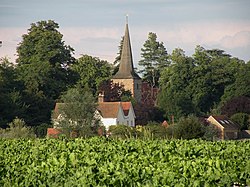Fairstead
| Fairstead | |
| Essex | |
|---|---|
 Hall Farm and Fairstead Church | |
| Location | |
| Location: | 51°49’24"N, 0°33’56"E |
| Data | |
| Population: | 290 (2011[1]) |
| Post town: | Chelmsford |
| Postcode: | CM3 |
| Dialling code: | 01245 |
| Local Government | |
| Council: | Braintree |
| Parliamentary constituency: |
Witham |
Fairstead is a parish in the Witham hundred of Essex. Whilst isolated in a community of farming hamlets, the parish of Fairstead has close connections with Great Leighs and is roughly ten miles from Chelmsford, Essex's county town.
The parish encompasses the hamlets of Fuller Street & Ranks Green. Fairstead (including Faulkbourne) had a population of 290 according to the 2011 census.[1] In the 1870s, Fairstead was described as being:
- "a parish in Witham district, Essex; 2¼ miles SW of White Notley r. station, and 4 WNW of Witham."[2]
The Square and Compassess pub dates back to 1652, it was originally two farming cottages. Fairstead sits on the Essex Way, a popular 81-mile waymarked long-distance footpath.
Etymology
The name 'Fairstead' originates from Old English, meaning 'fair place'.[3] Fair (fæger) meaning fair, beautiful or pleasant.[3] Stead (stede) meaning 'A place, a site, a locality; a religious house or foundation; a place of communal activity; a farm, a dairy-farm, an estate.'[3] Fair probably means a travelling fair. Thus 'fairstrad' is the place where a fair was held.
Population
In the Domesday Book of 1086, Fairstead had a total population of "17 households".[4]
In 1881, Fairstead's population was predominately male, with men outnumbering women 82:64. The majority of males listed their occupation as working in agriculture, with 66 of the males working as farmers or a similar occupation. 48 of the 66 women in Fairstead were listed as "Unknown Occupation", this possibly indicate that they worked at home or were housewives.
According to the 2011 Census, there are 133 households in Fairstead, accommodating 290 people; 158 males 132 females.
Education
In 1818, the education in Fairstead consisted of, "A day school, supported at the expense of the rector, containing 20 children. The poor have ample means of educating children."[5] Education had developed by 1833, with Fairstead having "One Day and Sunday School, supported by the Rector, in which 22 males and 18 females attend daily, and 12 males and 4 females in addition on Sundays."[6] By 1867 attendance and facilities had increased:
- "There is both a day and night school in Fairstead, not in connexion with Government, held in a large room in a cottage, attended by from 40 to 50 children. The night school is taught by the rector, with the aid of the school-mistress."[7]
Nowadays the nearest primary and secondary schools are located in Great Leighs, Terling and White Notley.
Transport
The nearest town is Witham, approximately four miles to the south-east, followed by Braintree, approximately five miles to the north. Train services are available from nearby White Notley and Cressing, on the Braintree Branch Line. Trains to London take between 45 minutes and an hour, terminating at Liverpool Street.
References
| ("Wikimedia Commons" has material about Fairstead) |
- ↑ 1.0 1.1 "Fairstead (Parish): Key Figures for 2011 Census: Key Statistics". Office for National Statistics. https://neighbourhood.statistics.gov.uk/dissemination/LeadKeyFigures.do?a=7&b=11123326&c=fairstead&d=16&e=62&g=6422730&i=1001x1003x1032x1004&m=0&r=1&s=1422368401515&enc=1. Retrieved 27 January 2015.
- ↑ Wilson, John Marius (1870). Gazetter of England and Wales. Edinburgh: A. Fullerton & Co.. http://www.visionofbritain.org.uk/place/6701. Retrieved 27 January 2015.
- ↑ 3.0 3.1 3.2 "Key to English Place-Names". http://kepn.nottingham.ac.uk/map/place/Essex/Fairstead. Retrieved 23 February 2015.
- ↑ "Open Domesday". http://domesdaymap.co.uk/place/TL7616/fairstead/. Retrieved 26 February 2015.
- ↑ Great Britain. Parliament., House of Commons (1819). A Digest of Parochial Returns Made to the Select Committee Appointed to Inquire Into the Education of the Poor (1818). Irish University Press.
- ↑ Great Britain. Parliament, House of Commons (1833). House of Commons Papers. 42.
- ↑ Great Britain. Parliament, House of Commons (1868). Reports from Commissioners.
